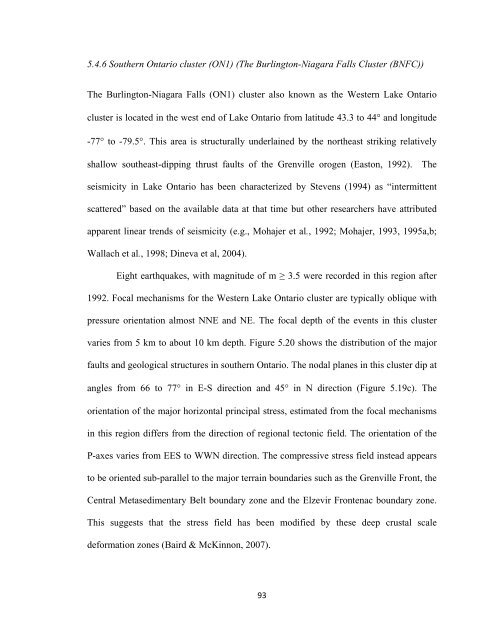western quebec and southern ontario - Department of Geology
western quebec and southern ontario - Department of Geology
western quebec and southern ontario - Department of Geology
Create successful ePaper yourself
Turn your PDF publications into a flip-book with our unique Google optimized e-Paper software.
5.4.6 Southern Ontario cluster (ON1) (The Burlington-Niagara Falls Cluster (BNFC))The Burlington-Niagara Falls (ON1) cluster also known as the Western Lake Ontariocluster is located in the west end <strong>of</strong> Lake Ontario from latitude 43.3 to 44° <strong>and</strong> longitude-77° to -79.5°. This area is structurally underlained by the northeast striking relativelyshallow southeast-dipping thrust faults <strong>of</strong> the Grenville orogen (Easton, 1992). Theseismicity in Lake Ontario has been characterized by Stevens (1994) as “intermittentscattered” based on the available data at that time but other researchers have attributedapparent linear trends <strong>of</strong> seismicity (e.g., Mohajer et al., 1992; Mohajer, 1993, 1995a,b;Wallach et al., 1998; Dineva et al, 2004).Eight earthquakes, with magnitude <strong>of</strong> m ≥ 3.5 were recorded in this region after1992. Focal mechanisms for the Western Lake Ontario cluster are typically oblique withpressure orientation almost NNE <strong>and</strong> NE. The focal depth <strong>of</strong> the events in this clustervaries from 5 km to about 10 km depth. Figure 5.20 shows the distribution <strong>of</strong> the majorfaults <strong>and</strong> geological structures in <strong>southern</strong> Ontario. The nodal planes in this cluster dip atangles from 66 to 77° in E-S direction <strong>and</strong> 45° in N direction (Figure 5.19c). Theorientation <strong>of</strong> the major horizontal principal stress, estimated from the focal mechanismsin this region differs from the direction <strong>of</strong> regional tectonic field. The orientation <strong>of</strong> theP-axes varies from EES to WWN direction. The compressive stress field instead appearsto be oriented sub-parallel to the major terrain boundaries such as the Grenville Front, theCentral Metasedimentary Belt boundary zone <strong>and</strong> the Elzevir Frontenac boundary zone.This suggests that the stress field has been modified by these deep crustal scaledeformation zones (Baird & McKinnon, 2007).93
















